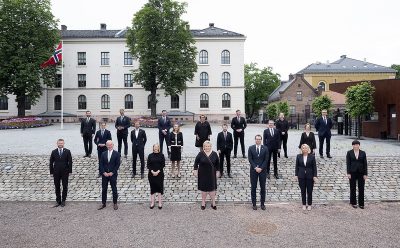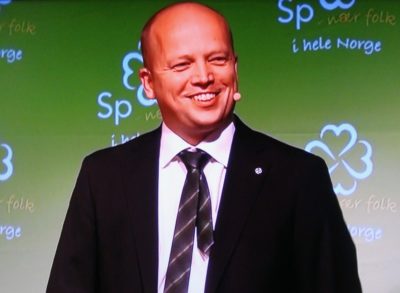NEWS ANALYSIS: It seems like the most favourite topic in Norwegian media lately is speculation over what Norway’s government will look like after this fall’s parliamentary election. Parties making up the current conservative government coalition are lagging badly in the polls, but the left-center side is divided by conflict and two very different candidates of its own for prime minister.

That’s left Norway with three candidates keen to lead the nation less than two months before the September 13 election. It’s also led to lots of confusion and finger-pointing, most recently at the leader of the protectionist and rural-oriented Center Party, Trygve Slagsvold Vedum.
The bald farmer-turned-politician from Hedmark, best known for his loud laughter, has been widely accused lately of “messing up” the political groundwork laid over the past few years to present two main coalition choices, one led by current Prime Minister Erna Solberg of the Conservatives and the other led by Labour Party leader Jonas Gahr Støre.
Polls have indicated for months that voters are weary of Solberg’s conservative coalitions of the past eight years, clearing the way for a new left-center government. Most thought Vedum would simply be willing to once again serve in such a government with Støre as prime minister. Now, however, Vedum is actively campaigning for the top job himself, as head of a center-left coalition of sorts that would seek support from both the left and the right depending on the pressing issue at hand.
“Voters have become confused,” wrote Kjell Werner, political commentator for the ANB media group that owns several left-leaning newspapers around Norway, earlier this week. “Vedum is messing things up for Støre by trying to build up his own government alternative. Erna Solberg is getting free points when he (Vedum) warns that Støre may have to depend on support from the Reds and Greens.” The latter are the smallest and most radical on the left side of Norwegian politics.
Vedum’s formerly small Center Party was a member of the last Labour-led left-center coalition that governed from 2005 until 2013, when Solberg’s conservative coalition first unseated them. Labour, led by Jens Stoltenberg at the time, dominated the left-center coalition with 35.4 percent of the vote, while Center and the Socialist Left (SV) each held around 6 percent.
Center later jumped in the polls (mostly at Labour’s expense) and largely because of a backlash to the Solberg government’s reforms that have resulted in unpopular mergers and consolidations of everything from county- and municipal governments to police– and hospital services. Center, with Vedum at the forefront, is campaigning to reverse many of those changes, to the point that he’s now widely branded as being as much of a populist as one of his traditional arch-rival Sylvi Listhaug, new leader of the now-ailing Progress Party. Center has even taken over Progress’ spot as Norway’s third-largest party, and Progress (which was part of Solberg’s coalition government during its first six years) has all but given up on this fall’s election. With only around 10 percent of the vote in recent polls, Progress is instead aiming for a comeback on 2025.

At one point earlier this year, the Conservatives, Labour and Center each held more than 20 percent of the vote, fueling Vedum’s ambitions. One of the most recent polls, conducted by research firm Norstat for newspaper Dagens Næringsliv (DN), showed Center with just 15 percent of the vote, however. That’s still much more than its last election result in 2017 of 10.3 percent, but much less than Labour’s jump to 27 percent. Some thought that would dampen Vedum’s zeal to rule, or at least form a government only with Labour and exluding their former partner SV. Not so, at least not yet.
It was Vedum’s first stated intention that his Center Party and Labour could rule alone that offended SV, which has risen in the polls itself and now holds around 8 percent of the vote. SV warns there’s little chance Labour and Center can win a majority of the vote on their own, meaning they’d thus have a minority government that would need support from other parties on an issue-by-issue basis. Vedum, undaunted by all the criticism from other parties, laid out last weekend how he’d do that, suggesting Center and Labour could win support from the Conservatives on issues involving oil, property rights, immigration and defense, and from the left on farm subsidies, more support for rural areas than cities, and when they need to get a state budget passed. That did not win support from any of the other parties in Parliament.
Labour, meanwhile, is now nearly twice as big as Center in the most recent polls and also re-emerged as Norway’s largest party in Norwegian Broadcasting (NRK)’s recent “super poll” in June that questioned roughly 10 times the number of Norwegian voters than in the monthly polls. If that trend continues, the voters themselves will dash Vedum’s premier hopes.
Labour leader Støre also insists on inviting SV into any future government coalition. While SV has publicly criticized Vedum and the Greens have called him “unsuitable” to be prime ministe, Støre has remained unusually quiet during the past few weeks of media coverage of Vedum’s campaign stunts around the country. Støre has tried to be on the offensive, even launching a pro-union- and workers plan for Labour’s first 100 days leading a government, but Vedum has been stealing the show. Both Center and SV also object to various parts of Støre’s plan. The left thus remains divided.
Solberg, meanwhile, is not giving up her chance for a third term as prime minister. She was out on the campaign trail herself last week and firmly rejected Vedum’s flirt for cooperation on oil, defense or other issues.
“He can’t think that he can wave away the fact that he’s campaigning for support from the left side of Norwegian politics,” Solberg told newspaper Aftenposten. “He has to remember that he has chosen his side.” She maintains that her own Conservatives are “a predictable party” that doesn’t engage in “the games others have played” during the past eight years in terms of “being against things they supported earlier.”

While her opponents and media commentators talk about forming various government coalitions, Solberg would rather talk about solutions to various political issues. “Conducting all kinds of analyses about how policy may be in various scenarios does not provide the right focus,” she said, adding that voters have seen her “government alternative” for the past eight years.
“And it’s all about cooperation between four parties (her own, the Liberals, Christian Democrats and Progress),” Solberg said, even though her three partners have alternately joined and left her government at different times and the Christian Democrats had their own flirt with Labour. “We have delivered state budgets and cooperated and are able to do that again,” Solberg told Aftenposten.
Her biggest problem is that all three government partners have fallen sharply in the polls, with both the Christian Democrats and Liberals still below the 4 percent of the vote needed for full representation in Parliament. The Liberals were down at 2.5 percent in DN‘s poll in late June, and the Christian Democrats landed at just 3.5 percent.
That’s what makes a change of government in September likely, barring any huge surge of support for Solberg’s Conservatives and/or her partners. “Our main point is that we must first let the voters vote,” Solberg said. “If there’s a non-socialist majority we will have a non-socialist government backed by four parties.”
“If there’s isn’t a non-socialist majority, I will expect the left side, including the Center Party, to work things out amongst themselves,” Solberg said, adding that Center will need to deal with both the Reds and Greens, too, even though they’re diametrically opposed on oil, climate and many work-related issues.
Solberg further distanced herself from Vedum by remarking during her campaign visits along the southern coast that “people living in the cities need help, too,” not just those in the rural areas that Center wants to build up. District politics is thus emerging as one of the biggest and thorniest isues of all, on both sides.
newsinenglish.no/Nina Berglund

